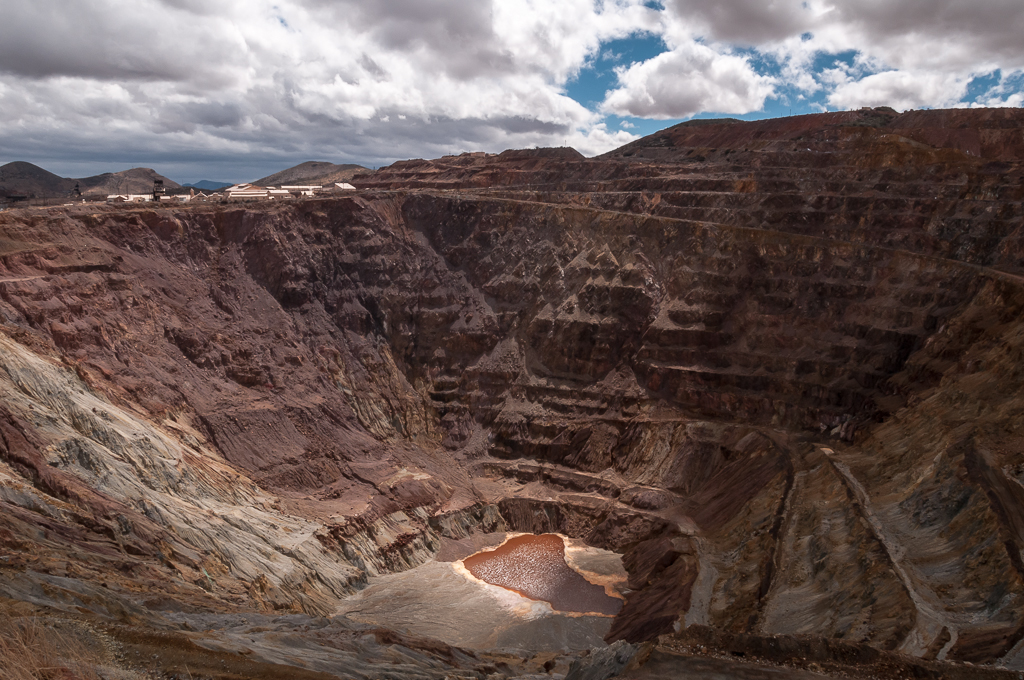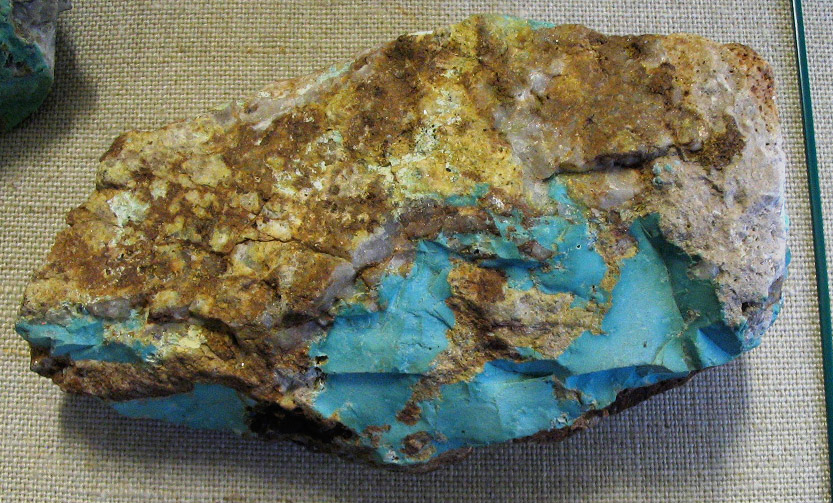|
Bisbee Blue
275px, Bisbee turquoise commonly has a hard chocolate brown colored matrix. Bisbee Blue or Bisbee turquoise refers to the turquoise that comes from copper mines located in the vicinity of Bisbee, Arizona. Bisbee turquoise can be found in many different shades of color and quality, from soft, low quality pale blue, to the quality hard brilliant blue turquoise and almost every shade of blue in between. The highest grade of Bisbee Blue turquoise is almost lapis lazuli blue and has a brownish-red spiderweb matrix. Green turquoise is also found in Bisbee. History Discovery Though small amounts of turquoise were found in the Campbell shaft mine, as well as in stream beds in the Mule Mountains, the vast majority of Bisbee turquoise surfaced when the Phelps Dodge Corporation started open pit mining operations at the location now known as the Lavender Pit, especially the eastern side of the pit. Large amounts of a conglomerate rock bed needed to be removed before the copper ore locate ... [...More Info...] [...Related Items...] OR: [Wikipedia] [Google] [Baidu] |
Conglomerate (geology)
Conglomerate () is a clastic sedimentary rock that is composed of a substantial fraction of rounded to subangular gravel-size clasts. A conglomerate typically contains a matrix of finer-grained sediments, such as sand, silt, or clay, which fills the interstices between the clasts. The clasts and matrix are typically cemented by calcium carbonate, iron oxide, silica, or hardened clay. Conglomerates form by the consolidation and lithification of gravel. They can be found in sedimentary rock sequences of all ages but probably make up less than 1 percent by weight of all sedimentary rocks. In terms of origin and depositional mechanisms, they are closely related to sandstones and exhibit many of the same types of sedimentary structures, e.g., tabular and trough cross-bedding and graded bedding.Boggs, S. (2006) ''Principles of Sedimentology and Stratigraphy.'', 2nd ed. Prentice Hall, New York. 662 pp. Friedman, G.M. (2003) ''Classification of sediments and sedimentary rocks.'' In G ... [...More Info...] [...Related Items...] OR: [Wikipedia] [Google] [Baidu] |
Phosphate Minerals
Phosphate minerals contain the tetrahedrally coordinated phosphate (PO43−) anion along sometimes with arsenate (AsO43−) and vanadate (VO43−) substitutions, and chloride (Cl−), fluoride (F−), and hydroxide (OH−) anions that also fit into the crystal structure. The phosphate class of minerals is a large and diverse group, however, only a few species are relatively common. Applications Phosphate rock has high concentration of phosphate minerals, most commonly of the apatite group. It is the major resource mined to produce phosphate fertilizers for the agriculture sector. Phosphate is also used in animal feed supplements, food preservatives, anti-corrosion agents, cosmetics, fungicides, ceramics, water treatment and metallurgy. The largest use of minerals mined for their phosphate content is the production of fertilizer. Phosphate minerals are often used for control of rust and prevention of corrosion on ferrous materials applied with electrochemical conversion co ... [...More Info...] [...Related Items...] OR: [Wikipedia] [Google] [Baidu] |
Villa Grove Turquoise
A villa is a type of house that was originally an ancient Roman upper class country house. Since its origins in the Roman villa, the idea and function of a villa have evolved considerably. After the fall of the Roman Republic, villas became small farming compounds, which were increasingly fortified in Late Antiquity, sometimes transferred to the Church for reuse as a monastery. Then they gradually re-evolved through the Middle Ages into elegant upper-class country homes. In the Early Modern period, any comfortable detached house with a garden near a city or town was likely to be described as a villa; most survivals have now been engulfed by suburbia. In modern parlance, "villa" can refer to various types and sizes of residences, ranging from the suburban semi-detached double villa to, in some countries, especially around the Mediterranean, residences of above average size in the countryside. Roman Roman villas included: * the ''villa urbana'', a suburban or country sea ... [...More Info...] [...Related Items...] OR: [Wikipedia] [Google] [Baidu] |
Durango, Colorado
Durango is a home rule municipality that is the county seat and the most populous municipality of La Plata County, Colorado, United States. The city population was 19,071 at the 2020 United States Census. Durango is the home of Fort Lewis College. History The town was organized from September 1880 to April 1881 by the Denver and Rio Grande Railroad (D&RG, later known as the Denver and Rio Grande Western railroad) as part of their efforts to reach Silverton, Colorado, and service the San Juan mining district, the goal of their "San Juan Extension" built from Alamosa Colorado. The D&RG chose a site in the Animas Valley close to the Animas River near what's now the Downtown Durango Historic Business District for its railroad facilities following a brief and most likely perfunctory negotiation with the other establishment in the area known as Animas City, two miles to the north. The city was named by ex-Colorado Governor Alexander C. Hunt, a friend of D&RG President William Jacks ... [...More Info...] [...Related Items...] OR: [Wikipedia] [Google] [Baidu] |
Turquoise Museum
Turquoise is an opaque, blue-to-green mineral that is a hydrated phosphate of copper and aluminium, with the chemical formula . It is rare and valuable in finer grades and has been prized as a gemstone and ornamental stone for thousands of years owing to its unique hue. Like most other opaque gems, turquoise has been devalued by the introduction of treatments, imitations and synthetics into the market. The robin's egg blue or sky blue color of the Persian turquoise mined near the modern city of Nishapur in Iran has been used as a guiding reference for evaluating turquoise quality. Names The word ''turquoise'' dates to the 17th century and is derived from the French ''turquois'' meaning "Turkish" because the mineral was first brought to Europe through the Ottoman Empire.Turquoise . minerals.usgs.gov ... [...More Info...] [...Related Items...] OR: [Wikipedia] [Google] [Baidu] |
Albuquerque, New Mexico
Albuquerque ( ; ), ; kee, Arawageeki; tow, Vakêêke; zun, Alo:ke:k'ya; apj, Gołgéeki'yé. abbreviated ABQ, is the most populous city in the U.S. state of New Mexico. Its nicknames, The Duke City and Burque, both reference its founding in 1706 as ''La Villa de Alburquerque'' by Nuevo México governor Francisco Cuervo y Valdés''.'' Named in honor of the Viceroy of New Spain, the Francisco Fernández de la Cueva, 10th Duke of Alburquerque, 10th Duke of Alburquerque, the city was Old Town Albuquerque, an outpost on Camino Real de Tierra Adentro, El Camino Real linking Mexico City to the northernmost territories of New Spain. Located in the Albuquerque Basin, the city is flanked by the Sandia Mountains to the east and the West Mesa to the west, with the Rio Grande and bosque flowing from north-to-south. According to the 2020 United States census, 2020 census, Albuquerque had 564,559 residents, making it the List of United States cities by population, 32nd-most populous city ... [...More Info...] [...Related Items...] OR: [Wikipedia] [Google] [Baidu] |
Rock (geology)
In geology, rock (or stone) is any naturally occurring solid mass or aggregate of minerals or mineraloid matter. It is categorized by the minerals included, its chemical composition, and the way in which it is formed. Rocks form the Earth's outer solid layer, the crust, and most of its interior, except for the liquid outer core and pockets of magma in the asthenosphere. The study of rocks involves multiple subdisciplines of geology, including petrology and mineralogy. It may be limited to rocks found on Earth, or it may include planetary geology that studies the rocks of other celestial objects. Rocks are usually grouped into three main groups: igneous rocks, sedimentary rocks and metamorphic rocks. Igneous rocks are formed when magma cools in the Earth's crust, or lava cools on the ground surface or the seabed. Sedimentary rocks are formed by diagenesis and lithification of sediments, which in turn are formed by the weathering, transport, and deposition of existing ro ... [...More Info...] [...Related Items...] OR: [Wikipedia] [Google] [Baidu] |
Lavender Pit
The Lavender Pit is a former open pit copper mine near Bisbee in Cochise County, Arizona, United States. It is located near the famous Copper Queen Mine. The Lavender Pit was named in honor of Harrison M. Lavender (1890–1952), who as Vice-President and General Manager of Phelps Dodge Corporation, conceived and carried out this plan for making the previously unprofitable low-grade copper bearing rock of the area into commercial copper ore. Phelps Dodge Corporation opened the Lavender Pit in 1950, at the site of the earlier, higher-grade Sacramento Hill mine. Production through 1974 totaled 86 million tons of ore averaging about 0.7% copper, or about 600,000 tons of copper produced, with gold and silver as byproducts. About 256 million tons of waste were stripped, but a portion of this was acid-leached for additional copper. Turquoise was also a by-product of this mining activity. Bisbee turquoise, also known as Bisbee Blue, is amongst the finest turquoise found anywhere in th ... [...More Info...] [...Related Items...] OR: [Wikipedia] [Google] [Baidu] |
Turquoise
Turquoise is an opaque, blue-to-green mineral that is a hydrated phosphate of copper and aluminium, with the chemical formula . It is rare and valuable in finer grades and has been prized as a gemstone and ornamental stone for thousands of years owing to its unique hue. Like most other opaque gems, turquoise has been devalued by the introduction of treatments, imitations and synthetics into the market. The robin's egg blue or sky blue color of the Persian turquoise mined near the modern city of Nishapur in Iran has been used as a guiding reference for evaluating turquoise quality. Names The word ''turquoise'' dates to the 17th century and is derived from the French ''turquois'' meaning "Turkish" because the mineral was first brought to Europe through the Ottoman Empire.Turquoise . minerals.usgs.gov Howe ... [...More Info...] [...Related Items...] OR: [Wikipedia] [Google] [Baidu] |
Phelps Dodge Corporation
Phelps Dodge Corporation was an American mining company founded in 1834 as an import-export firm by Anson Greene Phelps and his two sons-in-law William Earle Dodge, Sr. and Daniel James. The latter two ran Phelps, James & Co., the part of the organization based in Liverpool, England. The import-export firm at first exported United States cotton from the Deep South to England and imported various metals to the US needed for industrialization. With the expansion of the Western frontier in North America, the corporation acquired mines and mining companies, including the Copper Queen Mine in Cochise County, Arizona and the Dawson, New Mexico coal mines. It operated its own mines and acquired railroads to carry its products. By the late 19th century, it was known as a mining company. On March 19, 2007, Freeport-McMoRan completed a $25.9 billion acquisition of Phelps Dodge Corporation. History in 1821, Anson G. Phelps started a partnership in New York City with Elisha Peck, a merc ... [...More Info...] [...Related Items...] OR: [Wikipedia] [Google] [Baidu] |
Mule Mountains
The Mule Mountains are a north/south running mountain range located in the south-central area of Cochise County, Arizona. The highest peak, Mount Ballard, rises to . Prior to mining operations commencing there, the mountains were heavily forested with large Rocky Mountain Douglas-fir (''Pseudotsuga menziesii glauca'') and other conifers, but these were all cut down for housing needs and to feed the ore smelting furnaces in Douglas, Arizona, approximately 20 miles due east. Now, the primary vegetation of the Mules consists of manzanita (''Arctostaphylos'' spp.) brush, juniper, lowland oaks and pines, and various grasses. To the east of the mountain range lies Sulphur Springs Valley, and the San Pedro River and Valley to the west. The terrain is very rough, with very steep slopes descending into deep canyons. Common wildlife species include desert mule deer (''Odocoileus hemionus eremicus''), Coues' White-tailed deer (''O. virginianus couesi''), Collared Peccary (''Pecari ... [...More Info...] [...Related Items...] OR: [Wikipedia] [Google] [Baidu] |




.png)



